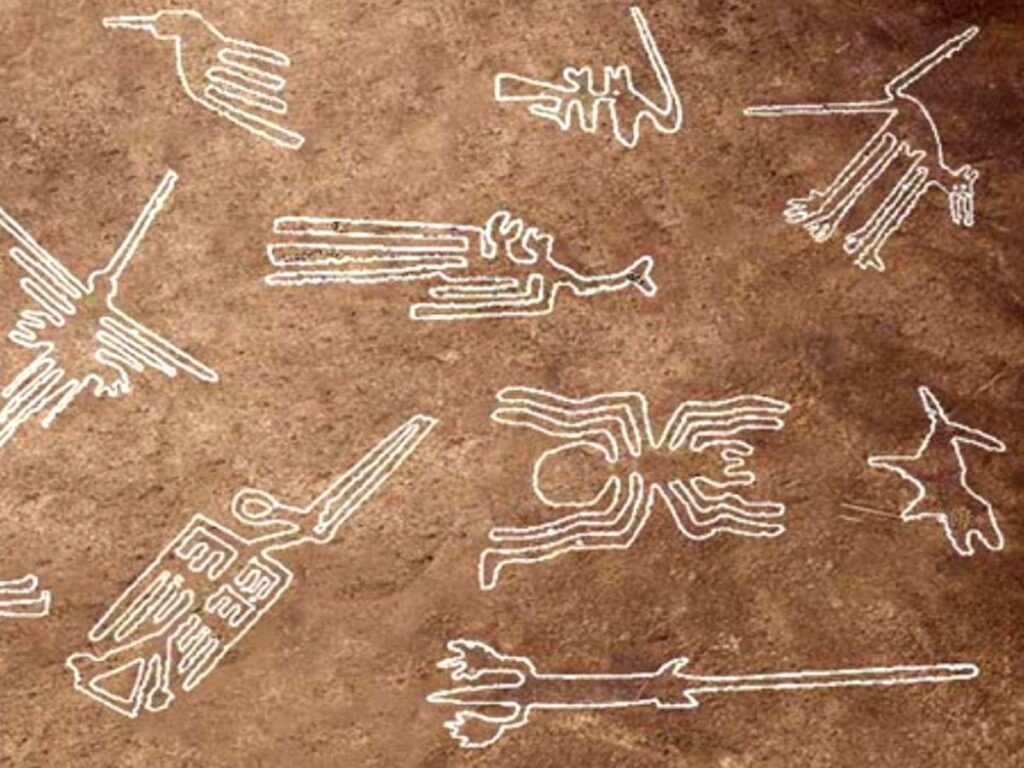
The Nazca Lines, a mysterious set of large geoglyphs etched into the desert floor of southern Peru, are one of the world’s greatest archaeological wonders. These lines, which stretch across the arid Nazca Desert, are believed to have been created between 500 BCE and 500 CE by the Nazca culture. The figures range from simple geometric shapes to complex depictions of animals, plants, and even human-like figures. The Nazca Lines have long intrigued archaeologists, historians, and travelers, and their exact purpose remains a mystery, adding to their allure and mystique.
Top Attractions in Nazca
1. The Nazca Lines (Flight View)
The Nazca Lines are best appreciated from the sky, and taking a flight over the desert is one of the most popular activities for visitors to the region. Several companies operate small aircraft that fly over the lines, offering incredible views of the vast desert and the geoglyphs etched into the earth.
- Geoglyphs of Animals and Shapes: Some of the most famous figures include the monkey, the hummingbird, the spider, and the whale. There are also geometric shapes like triangles, spirals, and trapezoids that span across the desert floor.
- Mystery and Theories: The purpose of the lines remains a mystery, with theories ranging from astronomical calendars to religious symbols or even alien communication.
2. The Nazca Lines Viewing Towers
For those who prefer to stay on the ground, there are two viewing towers located near the Nazca Lines that offer panoramic views of the desert and several of the geoglyphs. While the aerial view is the most popular option, these towers provide a unique perspective and allow for a closer look at the lines.
- Torre de Mira: The first tower is located just off the Pan-American Highway and offers views of the figures of the tree, the hands, and the lizard.
- Torre de Nazca: The second viewing tower is located slightly farther away and provides a broader perspective of the geoglyphs.
3. The Nazca Culture and Museum
To gain a deeper understanding of the Nazca civilization and their enigmatic creations, a visit to the Antonini Museum in Nazca is highly recommended. This museum houses a collection of artifacts, pottery, and textiles from the Nazca culture, offering insight into their daily life, art, and religious practices.
- Artifacts and Exhibits: The museum’s exhibits provide context for the Nazca Lines and the people who created them, helping visitors understand the history and significance of these incredible geoglyphs.
- Nazca Tombs and Mummies: The museum also features displays of Nazca mummies and tombs, which offer a glimpse into the burial practices of this ancient civilization.
4. Cahuachi Pyramids
Cahuachi, an ancient ceremonial site located about 28 kilometers (17 miles) from Nazca, was once a major center for the Nazca culture. The site consists of a complex of pyramids and temples, which were used for religious and ritual purposes.
- Archaeological Site: The pyramids of Cahuachi are a testament to the Nazca people’s engineering skills and their deep connection to religion and astronomy. Excavations at the site have revealed numerous artifacts and offerings.
- Touring the Site: A visit to Cahuachi allows visitors to explore the ruins and learn about the religious practices that may have influenced the creation of the Nazca Lines.
5. The Chauchilla Cemetery
Located about 30 kilometers (19 miles) from Nazca, the Chauchilla Cemetery is an ancient burial ground that dates back to the Nazca culture. The site features well-preserved mummies and tombs, offering insight into the customs and rituals of the Nazca people.
- Mummified Remains: Many of the mummies in the Chauchilla Cemetery are remarkably well-preserved, with their hair, clothing, and even facial features still visible.
- Burial Practices: Visitors can learn about the burial practices of the Nazca people, who believed in life after death and often included valuable items in the tombs to accompany the deceased into the afterlife.
Activities in Nazca
- Nazca Lines Flight: The highlight of any visit to Nazca is undoubtedly the flight over the Lines. Flights typically last between 30 to 45 minutes, offering breathtaking views of the desert and the mysterious geoglyphs.
- Archaeological Tours: Explore the surrounding areas on guided archaeological tours to visit ancient sites, learn about the Nazca culture, and discover the mysteries of the Lines.
- Sandboarding and Dune Buggies: For thrill-seekers, sandboarding and dune buggy rides are available in the desert surrounding Nazca. These activities provide a fun and adventurous way to experience the region’s desert landscapes.
Gastronomy in Nazca
While Nazca is most famous for its archaeological sites, the region also offers a variety of delicious Peruvian dishes. Traditional foods include fresh fish, locally grown corn, and the rich flavors of Andean cuisine.
- Ceviche: A Peruvian staple, ceviche is made with fresh fish marinated in citrus juice and served with onions, cilantro, and chili.
- Pachamanca: A traditional dish of the Andes, pachamanca is a feast made by cooking meat, potatoes, and corn in an underground oven.
- Local Desserts: For dessert, try “mazamorra morada,” a sweet pudding made from purple corn, or “turron de Doña Pepa,” a traditional Peruvian candy.
Best Time to Visit Nazca
The best time to visit Nazca is during the dry season, which runs from April to October. During these months, the weather is sunny and dry, making it ideal for flights over the Nazca Lines and exploring the desert landscapes. The rainy season, from November to March, brings occasional showers, which can make traveling to the area more challenging.
Practical Tips for Visiting Nazca
- Book Your Flight in Advance: Flights over the Nazca Lines can fill up quickly, especially during peak tourist seasons. Be sure to book your flight in advance to secure a spot.
- Altitude: Nazca is located at an altitude of around 500 meters (1,640 feet), so it is not considered high-altitude, but it’s always good to stay hydrated and rest during your visit.
- Sunscreen and Hat: The desert sun can be intense, so be sure to wear sunscreen, a hat, and sunglasses to protect yourself from the sun’s rays.
- Bring Cash: While larger towns in Peru have ATMs, it’s always a good idea to carry cash, especially if you plan to visit smaller villages or buy local handicrafts.
Accommodation in Nazca
Nazca offers a range of accommodations, from budget hostels to more comfortable hotels. There are several hotels located near the Nazca Lines viewing towers, making it easy for visitors to access the geoglyphs and other attractions.
Find accommodation options in Nazca on Booking.com.
Flight Information
The nearest airport to Nazca is in the city of Pisco, about a 3-4 hour drive away. Flights from Lima to Pisco are available, and from there, visitors can continue their journey to Nazca by bus or private transport.
Book your flights to Pisco with Skyscanner.
Conclusion
The Nazca Lines are one of Peru’s most enigmatic and awe-inspiring attractions. The sheer scale of the geoglyphs and the mystery surrounding their purpose continue to captivate travelers from around the world. Whether you’re flying over the lines, exploring ancient burial sites, or learning about the Nazca culture, a visit to this region offers an unforgettable experience. The unique combination of history, archaeology, and natural beauty makes Nazca a must-visit destination for anyone traveling through Peru





